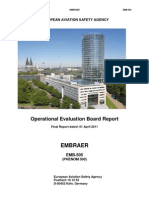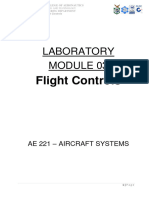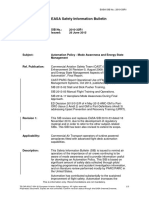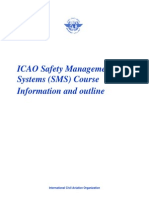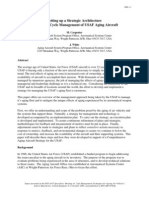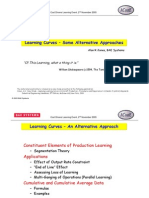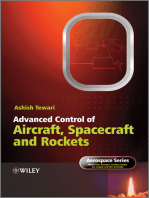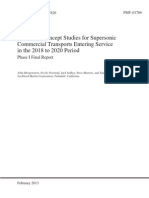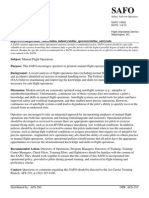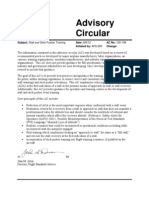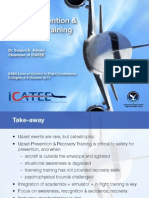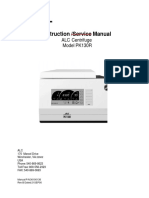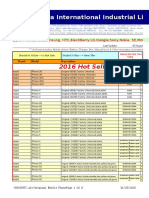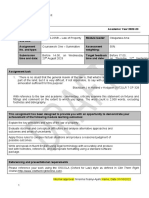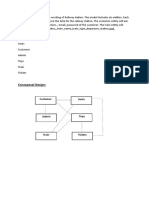EASA Automation Policy - Michel Masson
EASA Automation Policy - Michel Masson
Uploaded by
AvtipsCopyright:
Available Formats
EASA Automation Policy - Michel Masson
EASA Automation Policy - Michel Masson
Uploaded by
AvtipsOriginal Title
Copyright
Available Formats
Share this document
Did you find this document useful?
Is this content inappropriate?
Copyright:
Available Formats
EASA Automation Policy - Michel Masson
EASA Automation Policy - Michel Masson
Uploaded by
AvtipsCopyright:
Available Formats
Staying in Control - Loss of Control Prevention & Recovery EASA Conference, 4-5 Oct 2011, Cologne
EASA Automation Policy
Dr Michel A. Masson Safety Action Coordinator, HF Expert October 4th, 2011
Plan
Introduction The approach Most critical issues Paths for improvement Way forward
EASA Conference Staying in Control, 4-5 Oct 2011, Cologne
Quote
31 Aug 2011
EASA Conference Staying in Control, 4-5 Oct 2011, Cologne 3
EASA Automation Policy
The EASA Automation Policy adopts an innovative approach consisting of mapping crew-automation interaction issues, design and certification and training principles, and respective regulatory provisions to identify critical issues and paths for improvement
Being developed by the Internal Group on Personnel Training (IGPT) Action mentioned in the EASp
EASA Conference Staying in Control, 4-5 Oct 2011, Cologne 4
The EASA Internal Group on Personnel Training (IGPT)
Set-up in 2010 to follow-up the EASA International Conference on Pilot Training of Nov 2009 Scope expanded to all types of personnel Composed of experts from all operational Directorates of EASA
EASA Conference Staying in Control, 4-5 Oct 2011, Cologne
Plan
Introduction The approach Most critical issues Paths for improvement Way forward
EASA Conference Staying in Control, 4-5 Oct 2011, Cologne
1. Identify and group CrewAutomation Interaction issues
From a review of literature, 100+ entries were aggregated and grouped into 17 themes (not in ranked order): Transformation of pilots role Authority and control Monitoring and intent recognition Managing the automation versus flying the aircraft Simplicity of operation Aircraft types, variants, and (lack of) standardisation related issues Special equipment Flight crew co-ordination and communication Situation Awareness, mode awareness, failure detection and management
EASA Conference Staying in Control, 4-5 Oct 2011, Cologne 7
1. Identify and group CrewAutomation Interaction issues
Complacency, over-reliance on automation, decision making Workload management Error Management Information processing, integration and formatting Diagnostic and troubleshooting Alarm management Programming and related issues (for example of FMS) Database related issues
EASA Conference Staying in Control, 4-5 Oct 2011, Cologne 8
2. Bridge Design and Training Perspectives For each automation issue: How can it be mitigated by Design? How can it be mitigated by Training?
EASA Conference Staying in Control, 4-5 Oct 2011, Cologne
2. Bridging Design and Training Perspectives
Example: Issue: The Flight Crew dont select the level of automation appropriate for the task
EASA Conference Staying in Control, 4-5 Oct 2011, Cologne
10
2. Bridge Design and Training Perspectives
EASA Conference Staying in Control, 4-5 Oct 2011, Cologne
11
3. Prioritisation of issues
Based on expert judgment Simple Risk Matrix:
EASA Conference Staying in Control, 4-5 Oct 2011, Cologne
12
4. Identify and assess coverage in regulations (mitigations)
Design & Certification: CS and AMC 25.1302, Rulemaking Task CS Flight Crew FCL JAR-FCL 1.235, FCL 725.A et al., JAR-FCL 1.261 et al, Learning Objectives, Rulemaking task FCL.002, etc.
OPS
OPS 1.210, OPS 1.945, OPS 1.965, Appendix 1 to OPS 1.1045 B 2& B 3, OPS 1.978 (SOP), Appendix 1 to OPS 1.965, etc.
EASA Conference Staying in Control, 4-5 Oct 2011, Cologne
13
Plan
Introduction The approach Most critical issues Paths for improvement Way forward
EASA Conference Staying in Control, 4-5 Oct 2011, Cologne
14
Most critical issues (1/2)
Basic manual and cognitive flying skills tend to decline because of lack of practice and feel for the aircraft can deteriorate. Difficulties to understand the situation and to gain/regain control when automation reaches the limit of its operation domain and disconnects or in case of automation failure. When automation fails or disconnects, the tasks allocated to the pilots may fall beyond their capabilities. Unexpected automation behaviour leading to adverse consequences due to engagement/disengagement of automatisms in inappropriate context. Diagnostic systems are limited with regard to dealing with multiple failures, with situations requiring deviations from SOPs, or with the unexpected (no SOPs)
EASA Conference Staying in Control, 4-5 Oct 2011, Cologne
15
AAE Conference 2011
EASA Conference Staying in Control, 4-5 Oct 2011, Cologne
16
Most critical issues (2/2)
Unanticipated situations requiring to manually override automation are difficult to understand and manage, create a surprise effect, and induce a workload peak. Pilots interacting with automation can be distracted from flying the aircraft. Selection of modes, annunciation of modes, FD commands may be given more importance than value of pitch, power, roll and yaw and so distract the flight/crew pilots from flying the aircraft. Flightcrews may spend too much time trying to understand the origin / conditions / causes of an alarm whereas it is not necessary for the situation at hand Data entry errors (either mistakes or typing errors) made when using Electronic Flight Bags (EFBs) may have critical consequences. Errors may be more difficult to prevent and to detect (no system check of the consistency of the computed or entered values) as EFBs are out of the scope of Type Certification and there is no guarantee that they are designed in accordance with Human Factors standards.
EASA Conference Staying in Control, 4-5 Oct 2011, Cologne
17
Plan
Introduction The approach Most critical issues Paths for improvement Way forward
EASA Conference Staying in Control, 4-5 Oct 2011, Cologne
18
Paths for improvement
The European aviation system is globally well defended, providing all regulatory provisions and best practices are well and uniformly implemented. Furthermore, regulatory developments already planned in the Ops, FCL and CS domains will provide additional mitigations. Critical issues however deserve attention
EASA Conference Staying in Control, 4-5 Oct 2011, Cologne
19
Paths for improvement (1/3)
(Not an exhaustive list) Revise requirements impacting basic airmanship and manual flying skills Revise MPL/CBT requirements wrt Automation Management Revise the Multi Crew Cooperation (MCC) concept and Instruction requirements wrt Automation Management
EASA Conference Staying in Control, 4-5 Oct 2011, Cologne
20
Paths for improvement (2/3)
Revise recurrent training and testing requirements wrt Automation Mgt Improve operator Automation Policies and develop Automation Policies specific to AC types and variants Encourage manufacturers to publish Automation Policies and develop Automation Policies specific to AC types and variants
EASA Conference Staying in Control, 4-5 Oct 2011, Cologne
21
Wrt Operator Automation Policy
EASA Conference Staying in Control, 4-5 Oct 2011, Cologne
22
Wrt Operator Automation Policy
EASA Conference Staying in Control, 4-5 Oct 2011, Cologne
23
Manufacturer Automation Policy Examples
EASA Conference Staying in Control, 4-5 Oct 2011, Cologne
24
Manufacturer Automation Policy Examples
EASA Conference Staying in Control, 4-5 Oct 2011, Cologne
25
Paths for improvement (3/3)
Transfer of Certification assumptions with regard to flight crew competences to training (as used presently in the OEB). Consider getting the approval of safety critical functions of Electronic Flight Bags (EFBs) into the frame of Type Certification. Close the loop by ensuring a consistent and complete validation process between Certification and Standardisation. Continue involvement with Working Groups such as ICATEE, ICAO NGAP, etc.
EASA Conference Staying in Control, 4-5 Oct 2011, Cologne 26
European WP presented in ICAO A37
EASA Conference Staying in Control, 4-5 Oct 2011, Cologne
27
Plan
Quote EASA Automation Policy The IGPT and the EASp Conceptual model and scope The method step by step Paths for improvement Way forward
EASA Conference Staying in Control, 4-5 Oct 2011, Cologne
28
Way forward
Work in development:
Consolidation with stakeholders (manufacturers, operators, ) Coordination with Authorities: FAA, TCCA, etc., and ICAO Coordination with expert teams, such as ECAST, CAST, RASG, and EHFAG
EASA Conference Staying in Control, 4-5 Oct 2011, Cologne
29
Thank you for your attention
EASA Internal Group on Personnel Training (IGPT) Coordinator:
[email protected]
Safety Analysis and Research Department
Annex - The European Aviation Safety Plan (EASp)
The European Aviation Safety Programme (EASP) complements the State Safety Programmes (SSPs) Strategy (developed by the EC)
Policies and objectives
Programme: (developed by the EC)
Means for States to implement SSP (by the EC)
Plan: the EASp (developed by EASA)
European-wide priority actions (by EASA) 1st edition 2011-2114, now being revised
EASA Conference Staying in Control, 4-5 Oct 2011, Cologne 31
Published on the EASA SMS webpage
EASA Conference Staying in Control, 4-5 Oct 2011, Cologne
32
Training related Actions on the EASp
SAFETY PLAN FRAMEWORK SYSTEMIC ISSUES Working with States to address SSPs Working with States to foster the implementation of SMS in the industry Safety Management enablers Complexity of the system OPERATIONAL ISSUES COMMERCIAL AIR TRANSPORT BY AEROPLANES EMERGING ISSUES New products, systems, technologies and operations
Runway Excursions
Environmental factors
Mid-air collisions Controlled Flight Into Terrain Loss of Control In Flight Ground Collisions OTHER TYPES OF OPERATION Helicopters General Aviation
Regulatory considerations Next Generation of Aviation Professionals
HUMAN FACTORS AND PERFORMANCE EASA Conference Staying in Control, 4-5 Oct 2011, Cologne 33
Action Develop an Automation Policy
EASA Conference Staying in Control, 4-5 Oct 2011, Cologne
34
You might also like
- IFATSEA FSF Presentation ATSEP and Uberlingen - OptDocument18 pagesIFATSEA FSF Presentation ATSEP and Uberlingen - OptFabio Benitez100% (1)
- 9758 FFHH en ATM PDFDocument127 pages9758 FFHH en ATM PDFPipiripi100% (3)
- Synergies Between INCOSE SE Handbook, CMMI and DO-178BDocument16 pagesSynergies Between INCOSE SE Handbook, CMMI and DO-178BMoulay BarmakNo ratings yet
- EBT ICAO Manual Doc 9995.enDocument162 pagesEBT ICAO Manual Doc 9995.enАндрей ЛубяницкийNo ratings yet
- Active Directory Tutorial - LearnthatDocument47 pagesActive Directory Tutorial - LearnthatSarwer Patel100% (2)
- EASA Rule Making Forewords - Jean-Marc CluzeauDocument4 pagesEASA Rule Making Forewords - Jean-Marc CluzeauEnrique Chulvi ForteaNo ratings yet
- EMB 500 OEB Report FinalDocument39 pagesEMB 500 OEB Report Finalthefirst_thefirstNo ratings yet
- Booklet Elpac 2Document8 pagesBooklet Elpac 2Marios LouposNo ratings yet
- ICAO PANS-OPS Instrument Procedures DesignDocument3 pagesICAO PANS-OPS Instrument Procedures Designcaptainace212No ratings yet
- Helinots (O) - Non-Technical Skills For Offshore Transport Pilots 1Document20 pagesHelinots (O) - Non-Technical Skills For Offshore Transport Pilots 1Highspeed FlyboyNo ratings yet
- Aircraft Ground Handling and Human Factors NLR Final ReportDocument74 pagesAircraft Ground Handling and Human Factors NLR Final ReportPramod P NairNo ratings yet
- Asme GT2005 PDFDocument13 pagesAsme GT2005 PDFteknikpembakaran2013No ratings yet
- ATSEP System Equipment Rating Training Edition 3 (1) .0Document28 pagesATSEP System Equipment Rating Training Edition 3 (1) .0Krishna GhimireNo ratings yet
- Research and Guidelines For Implementing Fatigue Risk Management Systems For The French Regional AirlinesDocument4 pagesResearch and Guidelines For Implementing Fatigue Risk Management Systems For The French Regional AirlinescaturkokoNo ratings yet
- Fault Tree AnalysisDocument11 pagesFault Tree Analysisdr_hsn57No ratings yet
- AEA TRAININGMan Ed8Document198 pagesAEA TRAININGMan Ed8Brett SpurgeonNo ratings yet
- Laboratory Module 4 - Aircraft Pneumatics, Air Conditioning and Pressurization SystemsDocument6 pagesLaboratory Module 4 - Aircraft Pneumatics, Air Conditioning and Pressurization Systemsralph trasmanasNo ratings yet
- 1.4 SAFA European Process - COLDocument35 pages1.4 SAFA European Process - COLInterogator5No ratings yet
- Manual On Aeroplane Upset Prevention and Recovery TrainingDocument94 pagesManual On Aeroplane Upset Prevention and Recovery TrainingAmgad Kamel MarzoukNo ratings yet
- Lessons Learnt From The Ariane Experience: Ing. Luca Del MonteDocument14 pagesLessons Learnt From The Ariane Experience: Ing. Luca Del MontemikeNo ratings yet
- 2018 Pilotphase CommreportDocument27 pages2018 Pilotphase CommreportAnonymous EzNMLt0K4CNo ratings yet
- Full download Commercial Aviation Safety, Sixth Edition 6th Edition – Ebook PDF Version pdf docxDocument47 pagesFull download Commercial Aviation Safety, Sixth Edition 6th Edition – Ebook PDF Version pdf docxdaramebelawu100% (1)
- Acas Xa - : Moving ForwardsDocument4 pagesAcas Xa - : Moving ForwardsPouryaNo ratings yet
- Upset Prevention & Recovery Training (UPRT)Document2 pagesUpset Prevention & Recovery Training (UPRT)tcalith100% (1)
- EASA Aviation Inspector Competencies ReportDocument17 pagesEASA Aviation Inspector Competencies ReportPero PericNo ratings yet
- Ep 95-0313 HazopDocument88 pagesEp 95-0313 HazopManjunathBVenkatesh100% (5)
- Contextualizing Aircraft Maintenance Documentation Final AuthorDocument21 pagesContextualizing Aircraft Maintenance Documentation Final Authorraimanchunagesh06No ratings yet
- Laboratory Module 3 - Flight ControlsDocument6 pagesLaboratory Module 3 - Flight Controlsralph trasmanasNo ratings yet
- Bent-Multi-Crew Pilots Licence ImplementationDocument10 pagesBent-Multi-Crew Pilots Licence ImplementationAjaz SheikhNo ratings yet
- European Helicopter Safety Team (Ehest) : Technological Solutions Mitigating Helicopter Safety IssuesDocument11 pagesEuropean Helicopter Safety Team (Ehest) : Technological Solutions Mitigating Helicopter Safety IssuesAeggabnuNo ratings yet
- Npa 2018-07 (B)Document222 pagesNpa 2018-07 (B)OratexaNo ratings yet
- Presentation 3 ENAC Italy New CRM Training ImplementationDocument12 pagesPresentation 3 ENAC Italy New CRM Training ImplementationPablo SánchezNo ratings yet
- Eucass2017 204Document16 pagesEucass2017 204joseph.mangan1892No ratings yet
- Easa Sib 2010-33R1 1Document3 pagesEasa Sib 2010-33R1 1mohamed.elbesseghiNo ratings yet
- Aircraft Digital Electronic and Computer Systems:: Principles, Operation and MaintenanceDocument10 pagesAircraft Digital Electronic and Computer Systems:: Principles, Operation and MaintenanceAasto Ashrita AastikaeNo ratings yet
- Development of Flight Test Instrumentation An Evolutionary PDFDocument18 pagesDevelopment of Flight Test Instrumentation An Evolutionary PDFmilad ghafaryNo ratings yet
- ICAO SMS Course Outline 2008Document10 pagesICAO SMS Course Outline 2008eliasox123No ratings yet
- Operational Evaluation Board Report: European Aviation Safety AgencyDocument41 pagesOperational Evaluation Board Report: European Aviation Safety AgencyPavlos Tsitswnis100% (1)
- Human Factors in Aircraft Maintenance Ok PDFDocument20 pagesHuman Factors in Aircraft Maintenance Ok PDFKaung MyatToe100% (1)
- #04. Heavy-Lifterlong Range Drone Logistics MarketDocument32 pages#04. Heavy-Lifterlong Range Drone Logistics MarketRodgers OkeyaNo ratings yet
- Investigation of Practical Flight PDFDocument327 pagesInvestigation of Practical Flight PDFlgq584520100% (1)
- Auto Matic Flight Controll 4-2Document141 pagesAuto Matic Flight Controll 4-2tarakae04No ratings yet
- Uk Caa - In2011 - 18Document5 pagesUk Caa - In2011 - 18Cengiz TurkogluNo ratings yet
- 02 WCM Investor DayDocument15 pages02 WCM Investor DaytkferaNo ratings yet
- EASA OEB Final Report Eurocopter AS365 EC 155 B B1!02!08022012Document42 pagesEASA OEB Final Report Eurocopter AS365 EC 155 B B1!02!08022012Jésus GomesNo ratings yet
- Techniacal Flights PDFDocument31 pagesTechniacal Flights PDFIvan Bastiani100% (1)
- Unusual SituationDocument50 pagesUnusual SituationReynir EinarssonNo ratings yet
- Usaf - Aging Aircraft ManagementDocument6 pagesUsaf - Aging Aircraft ManagementLeman LaymanNo ratings yet
- EASA News Special Okt 2012Document2 pagesEASA News Special Okt 2012amregistusNo ratings yet
- RAM Studies - Reliability, Availability and MaintainabilityDocument5 pagesRAM Studies - Reliability, Availability and Maintainabilityamr habibNo ratings yet
- Evolution of ICAO RequirementsDocument10 pagesEvolution of ICAO Requirementsneko_angel_nekoNo ratings yet
- Application of Learning Curves in The Aerospace Industry HandoutDocument34 pagesApplication of Learning Curves in The Aerospace Industry HandoutFillipe AndradeNo ratings yet
- Sense and Avoid in UAS: Research and ApplicationsFrom EverandSense and Avoid in UAS: Research and ApplicationsRating: 5 out of 5 stars5/5 (1)
- Automated Guided Vehicle Systems: A Primer with Practical ApplicationsFrom EverandAutomated Guided Vehicle Systems: A Primer with Practical ApplicationsNo ratings yet
- Modelling and Managing Airport PerformanceFrom EverandModelling and Managing Airport PerformanceKonstantinos ZografosNo ratings yet
- Static Analysis of Software: The Abstract InterpretationFrom EverandStatic Analysis of Software: The Abstract InterpretationNo ratings yet
- Rapid Prototyping Software for Avionics Systems: Model-oriented Approaches for Complex Systems CertificationFrom EverandRapid Prototyping Software for Avionics Systems: Model-oriented Approaches for Complex Systems CertificationNo ratings yet
- Advanced Control of Aircraft, Spacecraft and RocketsFrom EverandAdvanced Control of Aircraft, Spacecraft and RocketsRating: 4 out of 5 stars4/5 (1)
- Advanced Concept Studies For Supersonic Commercial TransportsEntering Service in The 2018 To 2020 Period.Document308 pagesAdvanced Concept Studies For Supersonic Commercial TransportsEntering Service in The 2018 To 2020 Period.AvtipsNo ratings yet
- The A330neo: Powering Into The FutureDocument22 pagesThe A330neo: Powering Into The FutureAvtips80% (5)
- FAA SAFO 13002 Manual Flight OperationsDocument1 pageFAA SAFO 13002 Manual Flight OperationsAvtips100% (1)
- FAA Advisory Circular (AC) 120-109Document26 pagesFAA Advisory Circular (AC) 120-109AvtipsNo ratings yet
- The Airbus Fuel Cell ApproachDocument38 pagesThe Airbus Fuel Cell ApproachAvtips100% (1)
- Risks Related To Lithium BatteriesDocument28 pagesRisks Related To Lithium BatteriesAvtipsNo ratings yet
- The ICATEE Programme - Sunjoo AdvaniDocument60 pagesThe ICATEE Programme - Sunjoo AdvaniAvtips100% (1)
- FAA Emergency Airworthiness Directive 2011-08-51Document4 pagesFAA Emergency Airworthiness Directive 2011-08-51AvtipsNo ratings yet
- Post Tension Tendon - How To Inspect A Post Tension TendonDocument4 pagesPost Tension Tendon - How To Inspect A Post Tension TendonmoshaNo ratings yet
- 5 Year Plan of TurismDocument16 pages5 Year Plan of TurismLokesh MeenaNo ratings yet
- The Philippine Government Under The Japanese OccupationDocument32 pagesThe Philippine Government Under The Japanese OccupationRandz Dgreat100% (1)
- Sample Assignment Brief Unit 6 - Maintenance of The Built EnvironmentDocument7 pagesSample Assignment Brief Unit 6 - Maintenance of The Built EnvironmentSuranga ManuNo ratings yet
- RF MEMS Switches and Switch Circuits: Shimul Chandra SahaDocument174 pagesRF MEMS Switches and Switch Circuits: Shimul Chandra SahaRajNo ratings yet
- ALC PK 130R-User ManualDocument27 pagesALC PK 130R-User ManualEng-Mugahed AlmansorNo ratings yet
- WK 1 - Travel Services - Tour 12 - Introducing The Philippine Tourism IndustryDocument81 pagesWK 1 - Travel Services - Tour 12 - Introducing The Philippine Tourism IndustryGrizlle Carpio AlvendiaNo ratings yet
- Introduction and Purpose: Retail Store Food FoodDocument38 pagesIntroduction and Purpose: Retail Store Food FoodM VNo ratings yet
- VANDA 2022 Parents Brieifng PresentationDocument15 pagesVANDA 2022 Parents Brieifng Presentationpp catNo ratings yet
- Price ListDocument56 pagesPrice ListDaniel LowNo ratings yet
- Hyundai I20 Brochure - South AfricaDocument10 pagesHyundai I20 Brochure - South AfricareshamdNo ratings yet
- Deewan-e-Hafiz (Farsi With Urdu Translation)Document499 pagesDeewan-e-Hafiz (Farsi With Urdu Translation)Talib Ghaffari93% (28)
- Enhancing Value & Customer SatisfactionDocument16 pagesEnhancing Value & Customer SatisfactionSamaresh PaikaraNo ratings yet
- Applications of Statistical Mechanics To Nance: Rosario N. Mantegna, Zoltan Palagyi, H. Eugene StanleyDocument6 pagesApplications of Statistical Mechanics To Nance: Rosario N. Mantegna, Zoltan Palagyi, H. Eugene StanleyNina BrownNo ratings yet
- Advanced Signal Processing Techniques: October 1991Document67 pagesAdvanced Signal Processing Techniques: October 1991linh duyNo ratings yet
- Financing Model-Understanding Startup Studio Structures - by John Carbrey - FutureSight - MediumDocument12 pagesFinancing Model-Understanding Startup Studio Structures - by John Carbrey - FutureSight - MediummberensteinNo ratings yet
- (2022) Tennant T7 Automatic Scrubber DatasheetDocument4 pages(2022) Tennant T7 Automatic Scrubber DatasheetkingsaktiNo ratings yet
- Play Group Mid Term Syllabus2024-2025Document3 pagesPlay Group Mid Term Syllabus2024-2025hackingwithcode71No ratings yet
- 03 - 315 - MVA - 400 - 220 - KV - Varsana - R2 - Jul08 - Jun - 10Document90 pages03 - 315 - MVA - 400 - 220 - KV - Varsana - R2 - Jul08 - Jun - 10ravi474No ratings yet
- Measures of Shape - Skewness and Kurtosis - MATH200 (TC3, Brown)Document10 pagesMeasures of Shape - Skewness and Kurtosis - MATH200 (TC3, Brown)3rlangNo ratings yet
- Exam Notification V SemDocument3 pagesExam Notification V Semvaidyam rahulNo ratings yet
- Lw602dm 22sb 22sbno 22sba 22sbano 22sbb 22sbbno 22sbc 22sbcno Law of Property Cw1 Assign BriefDocument5 pagesLw602dm 22sb 22sbno 22sba 22sbano 22sbb 22sbbno 22sbc 22sbcno Law of Property Cw1 Assign BriefS SaraNo ratings yet
- Sustainable Architecture: Visual and Acoustic ComfortDocument48 pagesSustainable Architecture: Visual and Acoustic Comfortnikita chawlaNo ratings yet
- Borda Niño - 2019 - Drivers of Tropical Forest Cover Increase - A Systematic ReviewDocument14 pagesBorda Niño - 2019 - Drivers of Tropical Forest Cover Increase - A Systematic ReviewJenickson CostaNo ratings yet
- Examination Report 5036303Document2 pagesExamination Report 5036303ankit trivediNo ratings yet
- Micro Machining-Module 3Document36 pagesMicro Machining-Module 3rejeesh_rajendranNo ratings yet
- Lesson 2Document50 pagesLesson 2dimarjavillo21No ratings yet
- Conceptual DesignDocument8 pagesConceptual DesignBASEERAT RAFIQNo ratings yet
- NASA&CIA Documents That Prove Flat&Non Rotating EarthDocument4 pagesNASA&CIA Documents That Prove Flat&Non Rotating EarthBigin BoBoNo ratings yet








